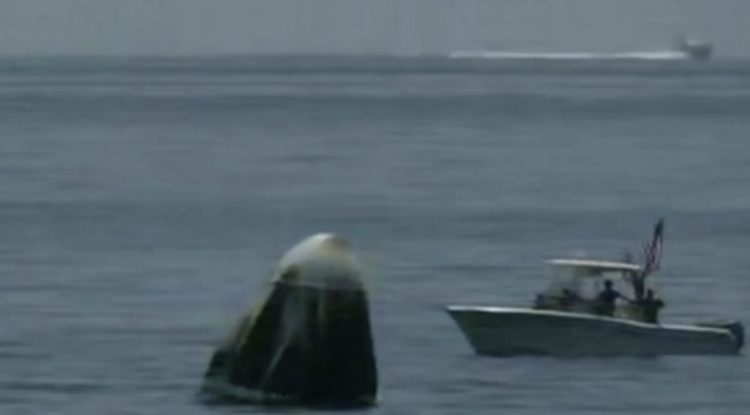The SpaceX Crew Dragon capsule crewed by NASA astronauts made the first spacecraft water landing in 45 years on Sunday, ending a journey to the International Space Station that sent American astronauts into orbit from U.S. soil for the first time since 2011.
NASA astronauts Bob Behnken and Doug Hurley boarded their Endeavour spacecraft and undocked from the station at 7:35 p.m. Eastern time Saturday as the space station flew 267 miles above Johannesburg. They landed in the Gulf of Mexico shortly before 3 p.m. Sunday, and SpaceX landing crews rode speedboats to recover the crew and equipment. The first boat is expected to check whether the Dragon capsule is leaking fluids or vapors. The second boat will retrieve Endeavour’s four parachutes, which the capsule ejects upon splashdown.
The Go Navigator recovery ship will then approach the Endeavour and hoist it aboard, allowing SpaceX crews to secure the capsule in place and open the side hatch to medically evaluate Behnken and Hurley before they disembark.
The astronauts will return to shore on the Go Navigator or a helicopter and fly to Ellington Field Joint Reserve Base in Houston and the Lyndon B. Johnson Space Center.
The landing marks the end of the first mission for a NASA crew aboard a private-sector spacecraft. SpaceX, owned by billionaire entrepreneur Elon Musk, beat out industry titan Boeing to send the first crewed mission to space as part of NASA’s commercial crew program. Hurley and Behnken lifted off from Kennedy Space Center in Cape Canaveral, Fla., on May 30, and spent 62 days aboard the ISS while NASA and SpaceX officials evaluated the Endeavour’s performance and flightworthiness.
Behnken and Hurley’s primary mission was to test the SpaceX Dragon capsule so NASA could evaluate future missions on the vehicle.
On the ISS, Hurley and Behnken took on the responsibilities of long-term crew members, helping NASA astronaut Chris Cassidy and cosmonauts Anatoly Ivanishin and Ivan Vagner maintain the station and conduct science experiments.
Hurley and Behnken helped install a new European drawer rack, a chest of drawers that can support experiments by providing power, data communication, cooling, nitrogen and venting waste gases. They took photographs for the Crew Earth Observation Study, which NASA uses to track changes on Earth’s surface, such as urban growth and reservoir construction, and natural events including hurricanes, floods and volcanic activity.
They helped Cassidy assemble and attach a “robotic tool stowage” unit to the outside of the ISS. NASA describes the device as a “robot hotel,” or a storage facility to robotic tools that can live outside the station instead of taking up valuable living space inside.
Behnken and Hurley also studied how liquids form into droplets in microgravity conditions, how bubbles are created through electrolysis and on the behavior of colloids, microscopic particles in liquid.
During their time on the ISS, they performed four spacewalks each, bringing their career totals to 10 apiece, tied for the most by American astronauts.
Send questions/comments to the editors.



Success. Please wait for the page to reload. If the page does not reload within 5 seconds, please refresh the page.
Enter your email and password to access comments.
Hi, to comment on stories you must . This profile is in addition to your subscription and website login.
Already have a commenting profile? .
Invalid username/password.
Please check your email to confirm and complete your registration.
Only subscribers are eligible to post comments. Please subscribe or login first for digital access. Here’s why.
Use the form below to reset your password. When you've submitted your account email, we will send an email with a reset code.